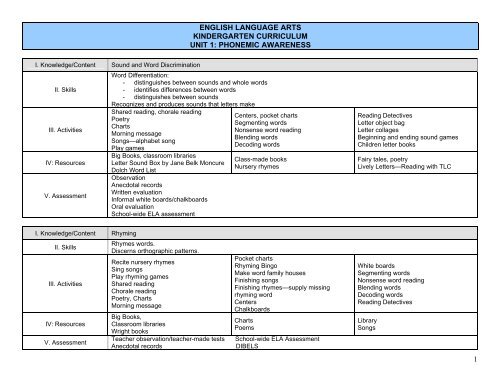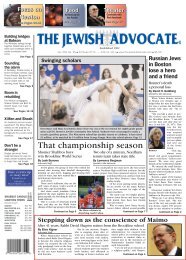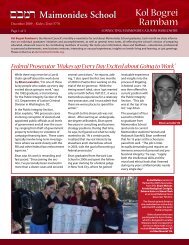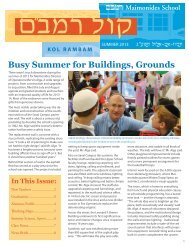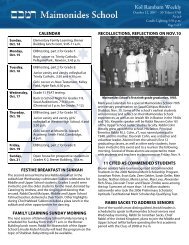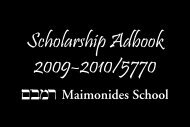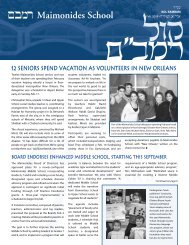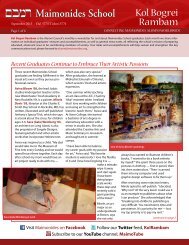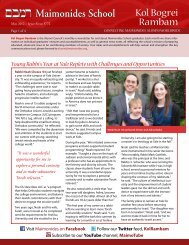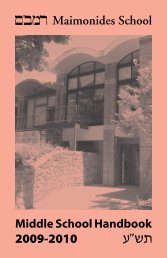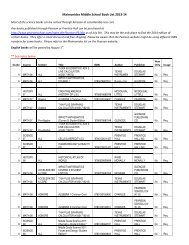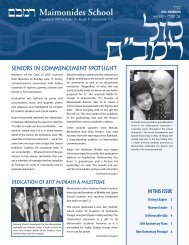1 english language arts kindergarten curriculum unit 1 - Maimonides ...
1 english language arts kindergarten curriculum unit 1 - Maimonides ...
1 english language arts kindergarten curriculum unit 1 - Maimonides ...
You also want an ePaper? Increase the reach of your titles
YUMPU automatically turns print PDFs into web optimized ePapers that Google loves.
ENGLISH LANGUAGE ARTSKINDERGARTEN CURRICULUMUNIT 1: PHONEMIC AWARENESSI. Knowledge/Content Sound and Word DiscriminationII. SkillsIII. ActivitiesIV: ResourcesV. AssessmentWord Differentiation:- distinguishes between sounds and whole words- identifies differences between words- distinguishes between soundsRecognizes and produces sounds that letters makeShared reading, chorale readingPoetryCh<strong>arts</strong>Morning messageSongs—alphabet songPlay gamesBig Books, classroom librariesLetter Sound Box by Jane Belk MoncureDolch Word ListObservationAnecdotal recordsWritten evaluationInformal white boards/chalkboardsOral evaluationSchool-wide ELA assessmentCenters, pocket ch<strong>arts</strong>Segmenting wordsNonsense word readingBlending wordsDecoding wordsClass-made booksNursery rhymesReading DetectivesLetter object bagLetter collagesBeginning and ending sound gamesChildren letter booksFairy tales, poetryLively Letters—Reading with TLCI. Knowledge/Content RhymingII. SkillsIII. ActivitiesIV: ResourcesV. AssessmentRhymes words.Discerns orthographic patterns.Recite nursery rhymesSing songsPlay rhyming gamesShared readingChorale readingPoetry, Ch<strong>arts</strong>Morning messageBig Books,Classroom librariesWright booksPocket ch<strong>arts</strong>Rhyming BingoMake word family housesFinishing songsFinishing rhymes—supply missingrhyming wordCentersChalkboardsCh<strong>arts</strong>PoemsTeacher observation/teacher-made tests School-wide ELA AssessmentAnecdotal records DIBELSWhite boardsSegmenting wordsNonsense word readingBlending wordsDecoding wordsReading DetectivesLibrarySongs1
I. Knowledge/Content BlendingII. SkillsIII. ActivitiesIV: ResourcesV. AssessmentOrally blends syllables or onset-rimes.Orally blends separate phonemes.Build wordsPoetryRead wordsPocket chartPlay gamesShared ReadingCh<strong>arts</strong>Chorale ReadingWord pattern gamesPartner reading,PoemsClassroom booksCh<strong>arts</strong>Library booksBook basketsLively Letters—TLC ReadingOral evaluation School-wide ELA AssessmentReading Written evaluationSegmenting wordsNonsense word readingBlending wordsDecoding wordsReading DetectivesPoetrySongsI. Knowledge/Content SegmentingII. SkillsIII. ActivitiesIV: ResourcesV. AssessmentDifferentiates between words and letters.Identifies and isolates initial sounds in words.Identifies and isolates final sounds in words.Separates and isolates sounds in words.Identifies and isolates syllables.Counts number of words in a sentence.Shared readingChorale readingPoetryCh<strong>arts</strong>Partner readingIndependent reading,Poems, ch<strong>arts</strong>Book basketsClassroom booksMorning messageSongs—alphabet songPlay gamesCenters, listening centerChalkboardsMagnetic boardsLibrary booksLively Letters—TLC ReadingOral evaluation School-wide ELA AssessmentObservation Teacher-made word listsWritten evaluation DIBELSWhite boardsPocket chartNonsense word readingReading DetectiveWorking segmented word puzzlesPoetrySongs2
ENGLISH LANGUAGE ARTSKINDERGARTEN CURRICULUMUNIT 2: PHONEMIC AWARENESSI. Knowledge/Content Awareness of PrintII. SkillsIII. ActivitiesIV: ResourcesV. AssessmentForms letters correctlyUnderstands directionality of printRecognition of words and lettersWrites using spaces between wordsUnderstands function of punctuationUses cues from different sources (picture cues, context cues)Sequencing skillsRecognizes connections between spoken and written <strong>language</strong>Locates front, back, title, name of author and illustratorShared readingChorale readingPoetryCh<strong>arts</strong>Partner reading,Songs—alphabet songIndependent readingPlay gamesRead namesMatching wordsStory writingMath storiesPoetry writingTrace lettersTrace in different mediasJournal writingSentence writingBrainstormingWebbingCreate listsLabelingPoetryBig BooksWright booksTeacher-made ch<strong>arts</strong>Classroom librarySchool libraryTeacher observation Running recordsWriting evaluations Center workReading School-wide ELA AssessmentChalkboard activitiesWhite board activitiesDifferent media formationArtWord wallLetter huntSequence picturesListening centerCentersReading the room—using pointers toread roomMorning message3
ENGLISH LANGUAGE ARTSKINDERGARTEN CURRICULUMUNIT 3: READING AND LISTENING FOR COMPREHENSIONI. Knowledge/Content Applying Comprehension Strategies and SkillsII. SkillsIII. ActivitiesIV: ResourcesV. AssessmentRecognizing beginning consonant letter-sound associations in one-syllable wordsDeveloping and writing sight wordsReading simple patterned text and predicting texts using letter-sound knowledge and pictures to construct meaningRecognizing and understanding words, signs, and symbols seen in everyday lifeIdentifying words in common categories such as color words, number words, and directional wordsDemonstrating a sense of story (beginning, middle, end, characters, details)Demonstrating familiarity with a variety of books and selections (picture books, caption books, short informal texts, nurseryrhymes, puppets, plays, reenactments of familiar stories)Development of inquiryRetelling, reenacting, or dramatizing stories or p<strong>arts</strong> of stories, including personal eventsRole-playing and acting out stories (fairy tales, songs, rhymes)Following simple oral instructionsRead to studentsIndependently readChorale read, partner readFlash cardsNursery rhymesManipulate letters to build wordsClassroom librarySchool libraryWright booksRigby booksDolch listPoetrySongsPuppets, puppet theaterPlaysSequence picturesLibraryReading logs Reading comprehension questionsRunning records School-wide ELA AssessmentCreate listsCh<strong>arts</strong>Read-Aloud booksDramatic playRecreating stories4
ENGLISH LANGUAGE ARTSKINDERGARTEN CURRICULUMUNIT 4: WRITING AND SPEAKING—STUDENTS COMMUNICATE THROUGH SPEECH AND WRITINGI. Knowledge/Content Developing Writing Strategies and SkillsII. SkillsIII. ActivitiesIV: ResourcesForms letters correctlyWrites using spaces between words to express own meaningRepresents spoken <strong>language</strong> with phonetically accurate or conventional spellingUses phonemic awareness and letter recognition to spell independently.Uses resources (word wall, signs) to enhance vocabularyWrites from left or right and from top to bottomBuilds a repertoire of some conventionally spelled wordsWrites to express own meaningNames or label objects or placesTrace lettersTrace in different mediasJournal writing, sentence writingBrainstorming, webbingCreate listsLabeling, poetryHandwriting Without TearsLively LettersChalkboard activitiesWhite board activitiesDifferent media formationArtWord wallModeling by teacher with poems/ch<strong>arts</strong>V. Assessment Writing samples School-wide ELA AssessmentReading the roomUsing spacer markers between wordsWood piecesWork matsLetter huntWord wallI. Knowledge/Content Speaking to Convey InformationII. SkillsIII. ActivitiesIV: ResourcesV. AssessmentUse correct words to name objects or tell actionsClarify and sort words by general categoriesUse speaking skills to connect experiences by listening to and retelling stories, taking turns, expressing ideas, and askingquestionsRetell, reenact, or dramatize stories, or p<strong>arts</strong> of stories, including personal eventsInterviewing peoplePairing and sharing; partner reading/workPlays/performancesDramatic playRecite poetry, recite rhymesTeacher-made playsObservation Oral evaluationTeacher-made worksheets PerformancesShow and tell Puppet centerGamesSharing, Show and Tell5
ENGLISH LANGUAGE ARTSKINDERGARTEN CURRICULUMUNIT 5: CULTURAL AWARENESSI. Knowledge/Content Language-Based Cultural InstructionListen to stories based on familiar themes and plotsII. SkillsDemonstrate familiarity with stories and activities related to various ethnic groups and countriesRelate characters and events to their own life experiencesRead, write, and or create art about: Thanksgiving, Jewish Holidays, Martin Luther King, Israel Independence Day, Folk Tales,and Presidents DayPerform in playsIII. ActivitiesShow and tellArt activitiesWritten expressionLibrary booksIV: ResourcesInternet resourcesObservationV. Assessment Teacher-made projectsArt6
GRADE 1 ENGLISH LANGUAGE ARTS CURRICULUMUNIT 1: LANGUAGE DEVELOPMENT (ONGOING UNIT)I. Knowledge/Content Phonemic AwarenessII. SkillsIII. ActivitiesIV: ResourcesV. AssessmentIdentify phonemesLetter-sound correspondenceSegmenting individual soundsManipulating sounds within wordsInitial, medial and final soundsPhonetic strategiesLong/short vowel soundsDigraphsSyllabicationRhymingDecodingReading (silent/oral fluency)CentersWord laddersMaking wordsWord family worksheetsGuided Reading Alpha KidsModern Curriculum Press Plaid PhonicsLevel AClass-generated word wallsSuccessful implementation of skills learned in readingSuccessful implementation of skills learned in writingSuccessful implementation of skills learned in speechRunning recordsDIBELSPhonological awarenessReading fluencyWord sortsBuilding words and writing words withletter tiles from picture cardsMorning message for editing andintroducing or reinforcing for specificskills to be learned or reviewedPocket Chart with reusable sentencestrips to reinforce skillsRecognize names or classroom objectsthat are segmented by soundRead AloudsTeacher-child selected home readingprogramListening centerWord sortsWord wallsMaking Words by Patricia CunninghamPrimary Concepts word study7
GRADE 1 ENGLISH LANGUAGE ARTS CURRICULUMUNIT 2: WRITINGI. Knowledge/Content Ability to Communicate Through PrintII. SkillsIII. ActivitiesIV: ResourcesV. AssessmentInventive spellingConventional spellingAppropriate use of upper/lower caselettersEncodingSimple sentencesJournal Writing with topicsFree Writing (student chooses topic)Interactive writingWord banks (subject related)Word Walls (geared towardsautomaticity)Quick Word DictionaryPunctuationComplex sentencesTopic sentencesSupporting details/alliterationConclusionsMorning messagePoetry WritingWriting Mini-LessonsWord MattersInteractive WritingReading journals Writing samplesWriting a story that tells who did what and whereRubrics School-wide ELA AssessmentRhymingSeasonal poetryEditingDictionaryPoetry writing center with word tiles(Primary Concepts)Reusable sentence strips at pocket chartcenterPrimary conceptsZaner BloserGRADE 1 ENGLISH LANGUAGE ARTS CURRICULUMUNIT 3: LITERATUREI. Knowledge/Content Genres of Literature (fiction, non-fiction, folklore, poetry)II. SkillsIII. ActivitiesIV: ResourcesV. AssessmentIdentifying story elementsPredicting story eventsIdentifying character traitsUsing pictures for cluesAbility to recognize patterns in storiesBooks on tapeRhythmStory sequenceVocabulary developmentIdentifying underlying themes in storyModeling appropriate <strong>language</strong>Modeling reading with expressionGraphic organizersIllustrating to reinforce knowledge ofcharacter traitsBooks related to abovementioned topicsPicture booksPoetry anthologyAssorted read-aloudsVenn diagrams Student’s ability to retell stories and eventsSchool-wide ELA assessments DIBELSInflection and intonationVenn diagramsUnderstanding cause and effectMaking inferencesUnderstanding literal comprehensionDemonstrating knowledge of cause andeffect through discussion, illustrationWriting beginning, middle, end of storyGraphic organizers8
GRADE 2 ENGLISH LANGUAGE ARTS CURRICULUMUNIT 1: READINGI. Knowledge/Content Phonics (Review/Application)II. SkillsIII. ActivitiesIV: ResourcesV. AssessmentVI. Articulation/ThematicLong/short vowelsConventional spellingAccuracyDecodingDaily ReviewMorning EditLetter Sound Box (Jane Belk Mancure)Spelling School-wide ELA AssessmentJournals EditingSocial studiesScienceCurrent eventsHolidays and celebrationsReading and interpreting word problems in mathI. Knowledge/Content ComprehensionII. SkillsIII. ActivitiesIV: ResourcesV. AssessmentVI. Articulation/ThematicFluency/accuracyInference/literalAlliterationGuided readingPartner readingIndependent readingChoral readingBasal ReadersTrade BooksFiction/non-fictionTeacher observationPartner readingIndependent reading levelsSocial studiesScienceCurrent eventsHolidays and celebrationsReading and interpreting word problems in mathMain ideaSupporting detailsSequencingComprehension skills seriesClassroom libraryIndependent worksheetsOral fluency ratesBook reportsPredictionsContextD.E.A.R.“Time for Kids”Oral responsesSequencing/summation/retelling9
GRADE 2 ENGLISH LANGUAGE ARTS CURRICULUMUNIT 2: WRITINGI. Knowledge/Content GrammarII. SkillsIII. ActivitiesIV: ResourcesV. AssessmentSpellingPunctuationCapitalizationJournals (ELA, science)HandwritingEditing with partnersLetter writingRead/response journalsD.E.A.R.BrainstormingDictionaryMad LipsMorning messageWhole group lessonsVerb tenseDescriptive words (adjectives/adverbs)Daily edits Spelling testsDaily writing HomeworkOral/written responses School-wide ELA AssessmentComplete sentencesVariety of sentencesGRADE 2 ENGLISH LANGUAGE ARTS CURRICULUMUNIT 2: WRITINGI. Knowledge/Content Topic DevelopmentII. SkillsIII. ActivitiesIV: ResourcesV. AssessmentParagraphTopic sentenceSupporting detailsShape BooksEssay writingFlip booksHomeworkEssay/story (more than one paragraph)SequencingBook reportsMatching form/style of authorsWriting from alternating perspectivesCharacter developmentPlaysPoemsGuided readingIndependent readingDaily editsGroup discussionBook reports Essays School-wide ELA AssessmentSelf-editing Rubrics10
GRADE 3 ENGLISH LANGUAGE ARTS CURRICULUMUNIT 1: READING FICTION/NON-FICTIONI. Knowledge/ContentII. SkillsIII. ActivitiesIV: ResourcesV. AssessmentVI. Articulation/ThematicHistorical context: background of passengers on ship and how differences in class affected amount of survivors, compare/contrastprice of tickets in 1912/2007Transatlantic travelCause/Effect: changing of regulations after sinking (ice patrol, radios, lifeboats per person)Discovery of remains of ship in 1987 (Dr. Robert Ballard)Write a complete paragraph including topic sent, 3 supporting details, concluding sentences, including correct punctuation andgrammar throughout <strong>unit</strong> to show understanding and recall of factsGraphing classes of passengers, cost of tickets, survivors per classRead for info and understandingConduct an interview with passenger based on internet info.Learning groups to research info,Interview Titanic passenger and write one pg. report,Reading groups based on reading and comprehension abilityConstruct a timeline of events leading up to disasterRead aloud to class Polar the Titanic BearShow illustrations/photos in various books and discussFiction/non-fiction literatureVideos, research websitesReading group novels – Tonight on the Titanic, On Board the Titanic, Titanic CrossingForm rubric for paragraph Evidence of self-correctingWritten test after completing novel School-wide ELA assessmentScience facts about sinking and floating, international navigation rules,Ties to math skills of graphing, money, sequencing time from PM to AM, word problems related to Titanic facts, calculating howmany passengers on each lifeboat and compare to maximum capacity, how many more could have been saved?11
GRADE 3 ENGLISH LANGUAGE ARTS CURRICULUMUNIT 2: READING BIOGRAPHIESI. Knowledge/ContentII. SkillsIII. ActivitiesIV: ResourcesV. AssessmentVI. Articulation/ThematicHistorical contextCultural influenceRead biography of various artists and describe their style (cubism, impressionism, post impressionism),Write paragraph to review learning of each artist (including p<strong>arts</strong> of speech noun/verb, complete sentences with correctpunctuation and capitalization, proper indentation)Keep running chart to compare/contrast dates of life, where they lived, style, extra personal information, audienceUse different art media to imitate the style of each artist (watercolor, crayon resist, 3D Picasso)Biographies of artists (Picasso, Renoir, Monet, Van Gogh, Cassatt), videos, foliosField trip to MFA to view artwork and compare/contrast to artists and style in the past,written test of biographical info. on each artist and his/her style, paragraph writingTied to <strong>unit</strong>s in Ms. Moore’s art classGRADE 3 ENGLISH LANGUAGE ARTS CURRICULUMUNIT 3: READING HISTORIOGRAPHYI. Knowledge/ContentII. SkillsIII. ActivitiesIV: ResourcesV. AssessmentVI. Articulation/ThematicStudy various groups of immigrants and why they emigrated (Irish, German, Italian, Jews, Russian, etc)Study various historical events (war, famine, persecution, etc. ) that led to immigration – what did U.S. have to offer?Ellis Island as point of entryRegulation, legislation, quotaCompare/contrastFact findingPrimary sourcesParagraph writingReading historical fiction novel based on ability/comprehensionCooperative learning groups, simulate entering Ellis Island (students dress as immigrants, bring bundle of goods, answer medicalquestions)Book groupsIndependent/collaborative researchReading material, historical fiction/non-fictionVideos, ch<strong>arts</strong>, graphsField trip to Lowell National Historic Site to summarize <strong>unit</strong>, view boarding house of immigrant workers, see factories, simulateimmigrant livesWritten book project after reading historical fiction book (become character in book)Book report based on The Streets of GoldRelated to Social Studies (study regions of Europe where immigrants originated)Math – graphing and estimating numbers of immigrants per country and specific yearsMath related facts/ measurement of p<strong>arts</strong> of Statue of Liberty12
GRADE 3 ENGLISH LANGUAGE ARTS CURRICULUMUNIT 4: READING—RESEARCHI. Knowledge/Content Research (American States)II. SkillsIII. ActivitiesIV: ResourcesV. AssessmentVI. Articulation/ThematicGenerate questions to research for report including climate, population, diversity of inhabitants, resources, tourist sites,topographyRead material from school libraryVisit public library to find books and researchHighlight info. and take notes on notecardsWrite rough draftWrite final report (including own map, cover, bibliography, one –two page report with separate paragraphs that include topic sent,supporting details, concluding sentence with proper grammar, spelling, capitalization, and punctuation)How to write a bibliography for a book, article, or website (including author’s name, title of book/article, date and place ofpublication)Draw a map of state including bordering states/rivers/oceansCreate an additional project (poster, song, poem, recipe, diorama, etc) that ties into state researchedKeep to specific deadlines to meet all report requirements (weekly check in with teacher)Highlight facts in class to demonstrate how to highlight and jot down notes on cards, read Time for Kids articles that relate toregions of U.S.Non-fiction books, internet, atlas, almanac, newspaper articles, travel brochures of various U.S. statesPresent written report and additional project to class, teacher observation as deadlines approach, teacher conference with eachstudent to check inReview of map skills studied earlier in the yearGRADE 3 ENGLISH LANGUAGE ARTS CURRICULUMUNIT 5: READING POETRYI. Knowledge/ContentII. SkillsIII. ActivitiesIV: ResourcesV. AssessmentVI. Articulation/ThematicStudy various genres of poetry (rhyming/non-rhyming)Conduct monthly poetry recitalsStudy works/biography of Henry Wadsworth LongfellowRead biography of LongfellowAnalyze various Longfellow poemsWrite various kinds of poetry andassemble into My Poetry BookAnalyze rhyme scheme patternsWrite poems (haiku, cinquain, acrostic, diamonte, clerihew, etc.), monthly poetry recitalsPoetry books, biography of LongfellowSyllabicationGrammar (follow poetry writing style, i.e.capitalize each line, phrases, use ofpunctuation to end/continue thoughts)Field trip to Longfellow House, Cambridge MA, write own poetry books (follow poetic rules for each poem including rhymescheme, specific syllabication)In reading about Longfellow, research what times were like in the 1700’s / Historical Context13
GRADE 4 ENGLISH LANGUAGE ARTS CURRICULUMUNIT 1: READINGI. Knowledge/ContentII. SkillsIII. ActivitiesIV: ResourcesV. AssessmentVI. Articulation/ThematicReading literature in order to acquire new information (reading for the purpose of learning)Reading literature for enjoyment, entertainmentDeveloping comprehension of both fiction and non-fiction literatureExploring different genres of literature such as historical fiction, fantasy, etc.Reading newspaper/on-line articles through the Current Event ProgramIdentifying main ideas, themesIdentifying literary elements such as character, setting, plotCreating visual representation of reading through the use of multiple graphic organizersPublishing written work, presenting it publiclyReading with expression through oral reading practiceModeling for beginning readers through the First Grade Reading Partners ProgramBi-weekly Time For Kids activitiesReading of at least three in-class novels in both mixed-ability and homogenous groupsMonthly Book Projects based on independent readingUse of a Free ReaderWeekly Reading Partners programWeekly Book Share presentationsClass and school librariesAssigned in-class literatureBi-weekly Time For Kids news magazineTeacher-provided excerpts or passages pertaining to specific holidays, historic individuals, etc.Teacher observations of oral reading skills Student responses (written or oral responses) based on read materialsTeacher-student conferencing Monitoring reading comprehension levelsSchool-wide ELA assessmentReading for the purpose of learning across all subject areasUsing literature as a source for the study of Native American culture and American colonial lifeUsing literature to examine grammar and vocabularyUsing literature as a source for current events discussions14
GRADE 4 ENGLISH LANGUAGE ARTS CURRICULUMUNIT 2: GRAMMARI. Knowledge/Content Formulation of grammatically correct sentencesCapitalizationEnd punctuation marksCommasQuotation marksII. SkillsP<strong>arts</strong> of speech (noun, verb, adjective, adverb)IndentationEditing marksProofreading and editingUse of reference textsUse of worksheetsIII. Activities Use of Wordly Wise seriesRelevant word games/activities in classEditing and proofreading students’ own writing/peer writingReference texts (including “Writer’s Express”, dictionary, thesaurus)Collected worksheetsIV: Resources Wordly Wise seriesRelevant word games/activitiesTeacher-designed peer-editing formTeacher observationStudent performance on in-class grammar assignments (including written or oral responses)Monthly book projects that demonstrate correct use of the skills learnedV. AssessmentAccurately editing peer writingUsing correct grammar in written responses across subject areasSchool-wide ELA assessmentUse of correct grammar in writing pertaining to science, social studies, music, art, etc.Comparing and contrasting grammar in English and HebrewVI. Articulation/ThematicComparing and contrasting our grammar with that of Native American tribesNoting the usage of grammar in our reading (particularly regarding other cultures)15
GRADE 4 ENGLISH LANGUAGE ARTS CURRICULUMUNIT 3: VOCABULARYI. Knowledge/ContentII. SkillsIII. ActivitiesIV: ResourcesV. AssessmentVI. Articulation/ThematicCorrectly spell and use introduced vocabulary words in written and oral responsesAdjust vocabulary words correctly according to usage (p<strong>arts</strong> of speech)Demonstrate use of expanding vocabulary orally/writtenMeaning and spelling of introduced vocabulary wordsUsing vocabulary words as different p<strong>arts</strong> of speech (noun, verb, adjective, adverb)Identifying synonyms/antonyms for introduced vocabulary wordsThesaurus skills to improve writingWeekly workbook exercisesWeekly packets developed for students requiring supportIn-class word games (for review)Improved free writersWordly Wise workbooksWeekly teacher-made assessments (leveled to ability)Reference materials (dictionary, thesaurus, websites)Student performance on workbook exercisesWeekly in-class assessments (leveled to ability)Teacher observation of student responses during in-class review or word gamesIncorporation of previously learned vocabulary into speech/writingIncorporate Wordly Wise vocabulary into responses (written/oral) for science, music, art, etc.Explore the roots of vocabulary words in other <strong>language</strong>s16
GRADE 4 ENGLISH LANGUAGE ARTS CURRICULUMUNIT 4: WRITINGI. Knowledge/ContentII. SkillsIII. ActivitiesIV: ResourcesV. AssessmentVI. Articulation/ThematicFormulation of grammatically correct paragraphs that include a topic sentence and supporting detailsFormulation of grammatically correct essays that include an introduction, body, and concluding paragraphFormulation of an expository essay that includes information gathered from various sourcesUse of rich <strong>language</strong>, including bold describing words and active verbsUse of an outlineNote-takingTopic sentences, supporting details, concluding sentencesIntroductory paragraph, body, and concluding paragraphProofreading and editingUse of free writersWriting a fictional narrative to be published in the class’ creative writing anthologyWriting essays for monthly Book ProjectsUse of relevant worksheetsIn-class note-taking practiceResearch conducted in the school library and on the laptop labEditing and proofreading students’ own writing/peer writingTeacher-designed outline, note-taking form, and peer-editing formCollected worksheetsSamples of excellent writing through literatureResearch materials (classroom and school libraries, laptop lab)Teacher observation Student performance on in-class writing assignmentsMonthly book projects that demonstrate correct use of the skills learned Accurately editing peer writingFormulating well-organized essays across subject areas School-wide ELA AssessmentWriting essays pertaining to topics in science, social studies, music, art, etc.Writing monthly Book Projects focusing on different types of writing (expository, persuasive, fiction, etc.)Writing a fairy tale with First Grade Reading Partner17
GRADE 5 ENGLISH LANGUAGE ARTS CURRICULUMUNIT 1: VOCABULARY DEVELOPMENT AND GRAMMARBy fifth grade, our students are very comfortable reading for information, both independently and in class. They also select age appropriate books to read for bookprojects and independent reading. They should be able to communicate their thoughts fluently both orally and in writing. Our program places heavy emphasis onreading and writing (with other skills being learned primarily through these two areas), critical thinking and integration with other curricular areas. Because there ismore social studies in fifth grade, there is less time devoted exclusively to <strong>language</strong> <strong>arts</strong>.I. Knowledge/ContentII. SkillsIII. ActivitiesIV: ResourcesV. AssessmentVI. Articulation/ThematicLearn and develop vocabulary skills through Wordly Wise <strong>curriculum</strong>Acquire new words; identify strategies that help students identify unfamiliar words as they readImprove and develop grammar skillsLearn the correct spelling and definition of words (especially multiple meanings)Prefixes, suffixes, and Greek/Latin roots—tools to help discover a word’s meaningUse context clues to learn what a word meansPractice spelling and usage of commonly confused words (such as there/ their, accept/ except)Editing skillsCapitalization—sentence st<strong>arts</strong>, proper nounsPunctuation—sentence endings, use of commas, apostrophes, semi-colons, colons, quotation marksOrganization of writing—descriptive phrases, transition wordsParagraph/ Sentence structure—combining sentences correctlyPractice activities (written, oral)Use vocabulary words in a variety of writing assignments (fiction, advertisement, current events and content areas)Review and introduce concepts especially as they occur in student writing Look at student and “professional” writing to identifyappropriately used conventionsWordly Wise 3000 5 th gradeReading materials for all subject areas (indirectly)Writers Express writing handbookVarious <strong>language</strong> <strong>arts</strong> workbooksStudent planners (English/ Language Arts resource section)The Girl’s Like Spaghetti by Lynne Truss and Bonnie TimmonsFor each <strong>unit</strong>, there is a quiz that assesses spelling, definitions, and using words correctly in sentences.Review games and activities after concluding 4-5 <strong>unit</strong>sUse words in context when writing storiesRecognizing the words (and their meaning) in textbooks and novelsAssess usage in student writing on vocabulary quizzes and longer piecesSchool-wide ELA AssessmentConnect words to current social studies and math <strong>unit</strong>s, as well as novels being studied (e.g. taxes on exported goods,equivalent fractions)18
GRADE 5 ENGLISH LANGUAGE ARTS CURRICULUMUNIT 2: READING AND READING RESPONSES (YEAR-LONG)I. Knowledge/ContentII. SkillsIII. ActivitiesIV: ResourcesV. AssessmentReading and identifying genres of literature—non-fiction, mystery, realistic fiction, short storiesElements of literatureFigurative <strong>language</strong>Understand plot, characters, settingIdentify and use figurative <strong>language</strong>Identify and use different points of viewMaking connections between personallife and global/ historic eventsSelecting quotes and details to supportopinionModel and practice strategies to usebefore, during, and after reading, suchas:- Predicting- Using titles, subtitles, and captions- Skimming- Finding key details- Activating prior knowledge and real-lifeexperiences- SummarizingComparing and contrasting book andmovie versions of the same story (Eyesof the Amaryllis)Reading non-fiction for pleasure andinformation (Time for Kids)Students independently read books and write 1—paragraph responses using a list of guiding questions.Read Revolutionary War-era historical fiction book independently; construct essay using promptsRead “classic” book independently; write 5-paragraph essay defending its status as classicClass read-aloudsLong-term book responses (i.e. create a game, analyze a classic, create a character scrapbook, essay about the book, bookreview)Novel choices may change, based onclass composition and current events, butinclude choices such as:- A Long Way from Chicago by RichardPeck- The Eyes of the Amaryllis by NatalieBabbittWhole-class and individual discussionsWritten responses (essays and questions)- The Kid Who Ran for President by DanGutman- The Best School Year Ever by BarbaraRobinsonOther short read-alouds, such asBaseball Saved Us, Essie Was Smart,and Amber Was BraveIndependently-read novels and nonfictionbooksTime for Kids semi-weekly publicationand resources19
GRADE 5 ENGLISH LANGUAGE ARTS CURRICULUMUNIT 3: WRITINGI. Knowledge/ContentII. SkillsIII. ActivitiesIV: ResourcesV. AssessmentCreative writing (may include prompts, such as Mysteries of Harris Burdick by Chris Van Allsburg)“I Am” poemWriting essaysWriting research projectsIdentify purpose for writingFor creative writing:Using figurative <strong>language</strong>Creating a story with a clear plot,protagonist, and antagonistFor “informative” writing:Clarity in communicating ideaEditing and revising skillsWriting storiesWriting persuasive paragraphs arguing student’s perspective“I Am” poemsMysteries of Harris Burdick by Chris Van AllsburgOther textbooks, novels, sample writingsAssessing writing based on rubrics, School-wide ELA Assessmentproject guidelinesRich vocabularyGRADE 5 ENGLISH LANGUAGE ARTS CURRICULUMUNIT 4: BIOGRAPHYI. Knowledge/ContentII. SkillsIII. ActivitiesIV: ResourcesV. AssessmentVI: Articulation/ThematicWrite a research report using 19th Century United States historical figures as contentDevelop self-editing skillsMake connections between the person being studied and the larger historical contextBasic research skills— note cards,outline, editing, revising, bibliographyWriting an effective introduction andconclusionWritten reports and oral presentation of subjectsOral presentation skillsTaking notes on presentations,comparing personal topic with reports ofothersBiography and reference books, encyclopedias from <strong>Maimonides</strong> LibraryCornell Writing Center and online resources—Steps to writing a research papersScholastic BiographiesEvaluate written report and oral presentation using evaluation checklistAssess student work and effort for each step of the processHigher thinking: making connections between individual subject and larger contextTeach effective ways to use Microsoft Word and PowerPointUsing a variety of sentence startersWriting in a formal tone20
GRADE 5 ENGLISH LANGUAGE ARTS CURRICULUMUNIT 5: NON-FICTIONBasic structure of the American GovernmentKey principles behind the government (democracy, republic, “common welfare”, federalism)I. Knowledge/Content Decision-making process, compromise, viewing different perspectivesBill of Rights, including freedom of expression, religion, right to vote, civil rightsThe Preamble and major related conceptsPractice K-W-L strategyMemorize and recite the PreambleOral discussion and presentation of ideasII. SkillsReading comprehension questions and discussionConnecting historical events to ideas in the ConstitutionEmpathizing with groups that have experienced discriminationWe the PeopleUS ConstitutionIII. Resources America Rock videosVarious short stories by Mildred Taylor, including The Gold Cadillac, excerpts from Roll of Thunder, Hear My CryThe Silent Lobby from The Book of PeaceTest of understanding facts Oral presentations;IV: Assessment respectful listening and sharing of opinions Reading comprehension questionsReciting the PreambleV. Articulation/Thematic Connections with Martin Luther King, Jr. Day, Black History Month21
GRADE 5 ENGLISH LANGUAGE ARTS CURRICULUMUNIT 6: HISTORICAL FICTIONI. Knowledge/ContentII. SkillsIII. ActivitiesIV. ResourcesV: AssessmentV. Articulation/ThematicUsing American Revolutionary War as content:Critical analysis of historical fiction (the “factual” vs. the “fictional”)Reading comprehension: main idea/ detail, summarizing—too much vs. insufficientTaking notesParagraph writing (review): strong introduction, supporting details, conclusionReading:• Reading different types ofsources for information:historical fiction, textbooks,“news-style” articles• Making inferences• Identify main ideas and details• Identifying point of view (politicaland literary)Writing:• Writing in “first person”perspective• Writing news article-style• Taking notes• Using graphic organizers torecord key details• Cause/effect• Sequence events• Write effective essay question fortests• Write effective 4-paragraphessay for historical fiction novelTrip to Minuteman Historical Park, directed research, textbooksOur Country textbookAmerica’s Story: Forming a New NationThe Revolutionary War book from libraryHistorical fiction books from this time periodCompleting graphic organizersShort-answer, multiple-choice, and short essay testShort-answer comprehension questionsWritten essay analyzing the plot and historical context of historical fiction novelMake connections to events that have occurred locally, such as Boston Tea Party, Boston Massacre, battle of Lexington andConcord22


